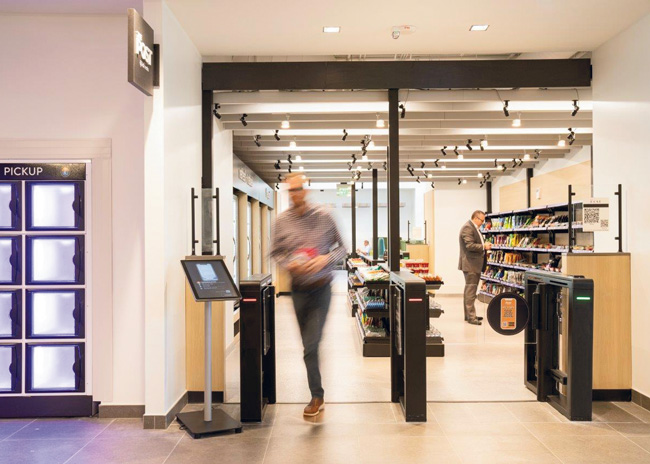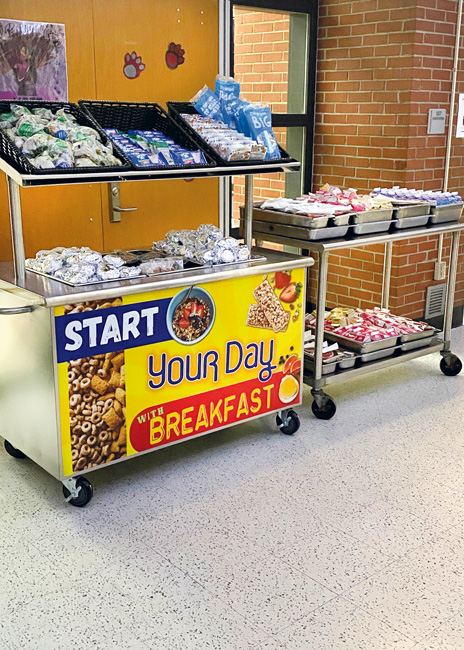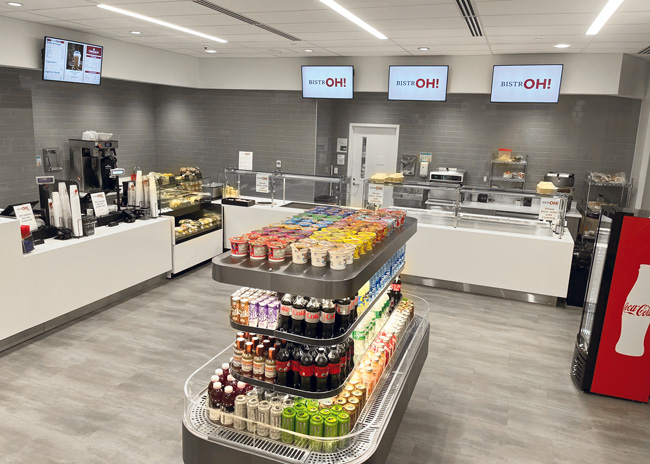College and K-12 school campuses continue to reimagine foodservice operations.
At the same time, corporate dining is still coming to grips with how to best serve office populations that are a fraction of what they were back in 2019. While these segments draw from very different customer bases, they align when it comes to considering distributed dining options as an operational strategy — a strategy that in many instances, drives incremental revenue.
Distributed dining essentially refers to establishing satellite feeding options. While distributed dining options can take many forms, they share one common thread in that they bring food closer to the customers.
“In corporate cafeterias, it’s designed to bring people back to work. In schools, its goal is to create smaller community hubs and to prevent large groups gathering. And in healthcare, distributed dining often aims to reach far-flung buildings,” says Scott Reitano, principal, Reitano Design Group, Indianapolis.
But it also works well for younger generations, Reitano says. “Gen Z and Gen Alpha aren’t breakfast, lunch and dinner folks. They want food available more often.” This trend is not going away, he points out, adding that “there’s a mental health piece — how do we take care of our people?”
Here’s a look at how this rapidly growing trend plays out across a variety of segments.
Healthcare Boosts Retail
The Ohio State University Wexner Medical Center in Columbus, Ohio, has 16 BistrOH! or BistrOH! To Go retail operations. Most are located within five miles of its main campus (though two are 18 miles away). For the most part, these units support the medical center’s growth in new buildings, says Julie Meddles, MS, RDN, LD, director of health system nutrition services and gift shops.
 Unmanned micromarkets, like this Aramark concept, can provide a 24/7 solution.When considering a new site, Meddles looks at the anticipated volume of staff, patients and guests, as well as what other food is available nearby. Other considerations include whether the food operation will be subsidized and whether it will break even or make a profit. She also works to ensure these operations have enough space.
Unmanned micromarkets, like this Aramark concept, can provide a 24/7 solution.When considering a new site, Meddles looks at the anticipated volume of staff, patients and guests, as well as what other food is available nearby. Other considerations include whether the food operation will be subsidized and whether it will break even or make a profit. She also works to ensure these operations have enough space.
Typically, these locations generate good sales volumes, Meddles says. “Having, at minimum, 500 staff in the building, plus regular flow of public patient and visitor traffic helps improve volume.”
All food is made in the central production kitchen in large batches and then distributed to the locations for finishing and a made-from-scratch appearance. This keeps food costs down and allows the foodservice department to control how much is distributed to each site, Meddles explains.
The food served depends on the location. “If we’re the only supplier of food, we need to have a decent-sized menu to appeal to the customer,” Meddles says. “We change our menu at minimum quarterly, but some buildings need changes more often since we are the only food provider, and we’d also have a bigger menu.” At some locations, she adds, menus are based on speed of service due to the needs of customers.
The design of each satellite location promotes maximum output and minimal staff needs. These locations do not have hoods, which saves on construction costs. As a result, staff bring 90% of food to proper serving temperatures by using ventless high-speed combi ovens. Other requirements are a small undercounter dishwasher, hand-wash sinks, a grease trap, backflow prevention/air gap and water that’s sufficiently hot, so adequate plumbing is always required. Some locations also have high-speed blenders.
Ideally these remote locations are on a first floor, near an entrance, preferably visible to patients and customers “and ideally our branded logo, BistrOH!, is very visible on great signage,” Meddles says. In several new buildings a red wall guides customers to the locations.
K-12 Schools Branch Out
Charleston County School District in North Charleston, S.C., provides foodservice kiosks in key areas around schools, which has helped increase participation in the breakfast program, says Walter Campbell, executive director of nutrition services. [Editor’s Note: Campbell retired at the end of 2023.] The kiosks also operate at lunch, and the district recently completed a major grab-and-go area in two high school classrooms, offering hot and cold food and a coffee station.
 The flow of students dictates where Charleston County School District places satellite kiosks.The kiosks sit in high-traffic areas, and the foodservice department watches the flow of students before committing to the location. “We don’t want to hinder the flow of students,” Campbell says. Next, he gets buy-in from the principal and administration and then purchases carts to serve the hot and cold food. The area also needs Wi-Fi for the POS equipment. Some carts stay put, and others roll to the back of the house after service.
The flow of students dictates where Charleston County School District places satellite kiosks.The kiosks sit in high-traffic areas, and the foodservice department watches the flow of students before committing to the location. “We don’t want to hinder the flow of students,” Campbell says. Next, he gets buy-in from the principal and administration and then purchases carts to serve the hot and cold food. The area also needs Wi-Fi for the POS equipment. Some carts stay put, and others roll to the back of the house after service.
It’s best to start small with the menu at these locations and ramp up, says Campbell, who also recommends launching with the most popular items. “You want to keep the line moving, so you need to streamline and make service as quick as possible,” he points out.
All hot food is cooked in the kitchen, so the kiosks don’t require any cooking equipment. Key items the kiosks do require include storage bins and a nearby water line if there’s a coffee machine.
When launching a kiosk, Campbell engages with the students. He starts with a pilot program to gauge interest and then runs a strong marketing program so students know what’s happening. If a kiosk isn’t working, he asks the students for feedback. “It could be as simple as they didn’t know they could get a meal at the kiosk under their meal program. Or they want to see new items at the kiosk. Or service was too slow,” he says.
Quest Food Management Services, a Lombard, Ill.-based contract feeder, typically adds satellite dining in middle and high schools to help address traffic flow limitations. Between 40% and 50% of the contractor’s middle and high schools have such operations, says Nick Saccaro, president. “Students’ days have become really compressed and they’re looking to avoid lines as much as they can,” he says.
These satellite locations are in high-traffic areas, ideally with students flowing in both directions. “We typically like to put them where guests are; not trying to get guests to come to a space they don’t typically frequent,” Saccaro says.
The spaces need access to water, drainage and electrical, handwashing sinks, and space to display or hang signs. Sometimes a spot that backs up against restrooms or a science lab can fulfill these requirements, Saccaro points out. Space is also necessary for lines to form and not cause ingress and egress issues.
Some satellite locations are self-sufficient, with refrigeration and dry storage, combi ovens and speed ovens, as well as holding cabinets and sometimes ice machines. If the space lacks those infrastructure requirements (especially storage or cooking equipment), then it needs to be a spot that’s closer to the main kitchen, Saccaro points out. And if the concept operates near the main serving area, it can’t seem like an afterthought or be located in a space that guests hit last, he adds. “It has to be as accessible as any other serving point,” he says.
Almost all food is precooked or parcooked in the main kitchen and then finished off at the satellite location. It is important to avoid menu creep, Saccaro warns, which can happen easily. This can make the menu much more difficult to execute, he explains, and can render the concept into a jumble of food. Ultimately, quality will suffer, especially if it’s more than the infrastructure can handle.
College and University Convenience
Colorado State University in Fort Collins, Colo., is experimenting with unmanned micromarkets. The campus has two of these self-service locations and will open two to three more in the next year. The markets are open 24/7, with evening being the most popular time. Students select their purchases and then check themselves out using their meal plan accounts or credit/debit cards.
The foodservice department plans to put the micromarkets in campus food deserts with the goal of keeping students on campus and able to get food after-hours. “We were trying to accomplish accessibility and value of the meal plan,” says Patrick St. Clair, assistant director, support services. “For the late-night crowd, we wanted to draw them in a little more.” The foodservice department also sought to provide an option for students with sensory issues, who may not be comfortable in a crowded dining hall.
 Around half of Quest’s middle and high schools have satellite dining options.The micromarkets receive food from the central production kitchen, and the catering staff manages these locations. Staff use golf carts to deliver the food. The typical micromarket stocks about 250 items, and the best sellers include energy drinks, sandwiches, sushi, pot stickers, salads, sweet items and chips.
Around half of Quest’s middle and high schools have satellite dining options.The micromarkets receive food from the central production kitchen, and the catering staff manages these locations. Staff use golf carts to deliver the food. The typical micromarket stocks about 250 items, and the best sellers include energy drinks, sandwiches, sushi, pot stickers, salads, sweet items and chips.
All food is sold cold, and students can heat it in microwaves at the location or take it to their residence. The micromarkets are also a great place to test out entrees, says St. Clair. The menu consists mainly of food from the CSU kitchen, but it also features some local items. “That’s another idea of these micromarkets: They’re a little higher end and we want to offer that same value if they’re not going to the all-you-care-to-eat facility,” he says.
When repurposing a space to create a micromarket, Colorado State adds some tables and maybe games like foosball or table tennis. “They’re pretty cost-effective because we haven’t had any buildouts,” says St. Clair. Key equipment items include security cameras, approximately 18 linear feet of shelving, refrigerators, beverage coolers, and freezers. These facilities have not required any additional power so far, though for the next location CSU may have to install an additional breaker for the freezer, St. Clair notes, adding that the buildout for that location should be less than $2,000. Coupled with the cost of the equipment and supplies, the CSU micromarkets cost roughly $20,000 each.
For the second location, Colorado State partnered with a national soft drink manufacturer, and added an 80-inch TV, some gaming chairs and tables, and branding, which St. Clair says gave it “a fun feel so students can plug in their own games and have tournaments.”
The biggest issue with the micromarkets has been theft, St. Clair says, mostly at the first location because the camera wasn’t well-placed. Cameras need to be really obvious, he points out. “It’s the placement of the camera that’s nailed it home for us.”
Corporate Dining Provides Options
Before COVID-19, contractor feeder Aramark started incorporating remote site solutions, primarily for third shifts or in remote buildings. With a slow return to in-office settings for many corporate employees, which directly impacts dining, remote foodservice solutions became a lifeline.
 Ohio State Medical Center opens BistrOH! locations to keep up with growth in new buildings.“They put foodservice closer to people and provide service 24/7,” says Gary Crompton, president and CEO of Aramark’s Workplace Experience Group. “We want people to feel good coming back to work. Foodservice is now an amenity and part of our engagement strategy.”
Ohio State Medical Center opens BistrOH! locations to keep up with growth in new buildings.“They put foodservice closer to people and provide service 24/7,” says Gary Crompton, president and CEO of Aramark’s Workplace Experience Group. “We want people to feel good coming back to work. Foodservice is now an amenity and part of our engagement strategy.”
Now, Aramark offers small-site solutions at nearly all of its accounts. Often these are micromarkets, unmanned or manned, and include bolt-on options to add a coffee station or other concepts.
Aramark’s micromarkets offer a variety of items, including sandwiches, hot food items that can be rethermed on-site, salads, snacks, and beverages including coffee. The food comes from commissaries, either run by Aramark or a third party, or from the main kitchen. Trucks that can hold rolling heated or chilled carts bring the food to the micromarkets.
This design allows these satellite operations to be mostly self-contained. Finding the necessary electricity is typically not a problem, but plumbing and ventilation can be harder. For that reason, equipment is ventless, which typically negates the need for hoods. And these satellite locations generally require very little equipment. Typically, these units require coffee machines, reach-in refrigerators, open-front refrigerators, speed ovens and dry storage.
Location plays a critical role in the success of these micromarkets, which need to be where people congregate, such as near break areas, coffee areas and ATMs; as well as where people work, Crompton points out. “People aren’t going to go to an area they don’t go to naturally.”
Aramark also leans on its Local Restaurant Row program to bring in local restaurants as a bolt-on to add variety to these satellite locations. Representatives from the restaurant bring in ready-made food and serve their dishes — reheated on-site, when applicable. Sites can choose from a selection of restaurants that Aramark has vetted.



